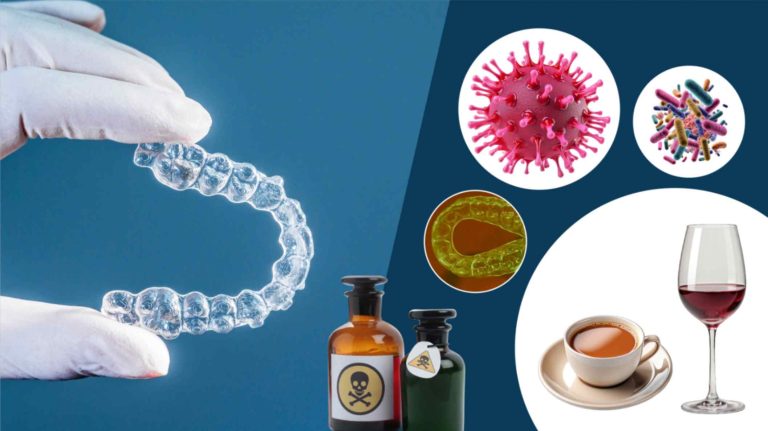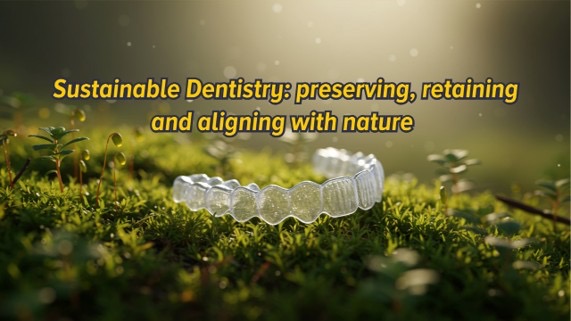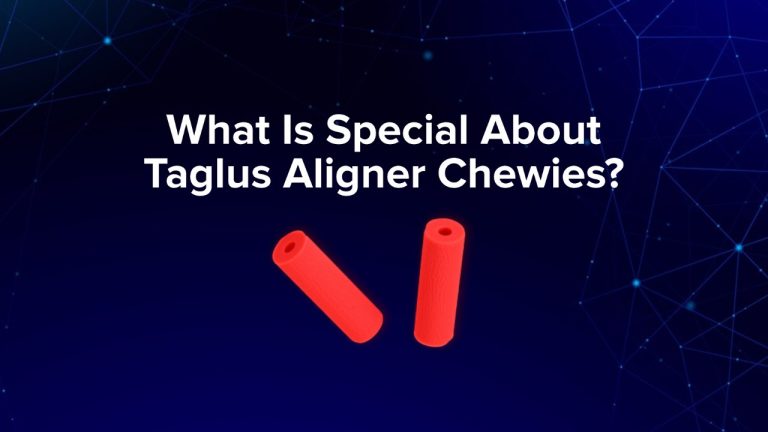Enquire Form
Factors Affecting the Transparency of Aligner Materials

Clear aligners are undoubtedly one of the most popular types of orthodontic treatment in modern orthodontics. They provide an invisible alternative to metal braces which makes them a preferred choice for those seeking a discreet way to get a well-aligned smile. However, many things influence the transparency of aligner materials. So, let’s dive into the science behind the transparency of aligners, the main factors influencing this, and how we can prevent its discolouration in the long run.
1. The Chemistry Behind Aligner Transparency
The secret behind aligner transparency is in their material. Most are made out of thermoplastic polymers. There are two very common types: polyurethane and polyethylene terephthalate glycol, or PET-G. These plastics are known for their strength, flexibility, and clarity.
For a material to look transparent, light will have to pass through it without scattering. Since the molecules in clear aligners are aligned in an order that allows easy passage for light, this material looks clear. With disorganization in its molecules, light scatters, and the aligner turns cloudy-looking. Amorphous thermoplastic polymers are preferred over crystalline polymers because of their increased level of translucency. When it comes to quantifying the amount of transparency, it is estimated that about 80% of light should be transmitted for a clear aligner material to be good enough to be used. Polyurethane, polyester, polyvinylchloride, polysulfone, and polycarbonate are a few materials that are preferred for making aligners because of their optical properties.
Of all the material options available, PU polymers attract more pigments which penetrate the material. PU contains the surface polar group –NHCOO- which increases its tendency to form hydrogen bonds, which in turn interacts with hydrophilic pigments leading to pigment adsorption. PETG polymers have –COO- and –C-O-C- as surface groups which are less polar than –NHCOO- and have a lower tendency for pigment adsorption.
Material thickness also has a role to play. The thinner the aligner, the less material there is, allowing the light to easily pass through. It can make it seem more transparent, but there must be a balance between how thick it needs to be for its strength and how thin it should be to maintain its transparency.
Manufacturing techniques also matter. More advanced technology results in less impurity and defects in the aligners. These aligners allow more light to pass through and remain clearer over time. Consistency of material thickness and quality during production is key to the fact that the aligner will stay clear when worn.
2. Important Factors Influencing Aligner Clarity
There are a few things that may reduce the clarity of the aligner. Let’s look at the most common factors:
- Scratches: As aligners are worn consistently, they tend to get scratches. It may be hard to see them, but it does scatter light, making it cloudy. The longer a person wears the aligner, the more signs of wear will be seen.
- Staining: Food items and drinks would leave stains on them. Coffee, tea, red wines, and dark fruits are the major culprits. These pigments penetrate the aligners with time and cause them to appear yellow or brown. Among some of the most commonly produced food products, turmeric, saffron, red chili powder, coffee, tea, and green tea were noted to bring a colour change in decreasing order of intensity. Therefore, it should be strictly recommended to the wearer to clean the mouth after eating or drinking anything except water.
- Saliva and Bacteria: Saliva and bacteria present in the wearer’s mouth adhere to the aligners. Saliva and bacteria cause the aligners to appear dull, discoloured, and cloudy. Furthermore, this impacts hygiene in the oral cavity, which may result in several other dental issues.
- Inadequate Cleaning: Poor cleaning agents can also damage the clarity of aligners. Using abrasive toothpaste or mouthwashes that contain alcohol may affect the quality or scratch the surface of the aligners. Such scratches hamper the clarity of the material.
- Time of Use: The longer the wearing duration of the aligners, the more prone they are to losing clarity. Ideally, aligners should be worn 22 hours a day, but of course, one should also replace them every one to two weeks as per the recommendation of the dentist.
All of these factors affect how well the aligners stay clear and invisible throughout treatment. Proper care and hygiene can minimize these effects and enable the aligners to stay transparent.
3. Why Is Colour Change Management Important?
Aligners should be nearly invisible, but when they become dingy or hazy, the invisibility decreases, and they become quite noticeable in a patient’s mouth. This can make a patient feel self-conscious and frustrated with the treatment. A patient may choose clear aligners partly because of their aesthetic quality. As such, discolouration detracts from it.
Discolouration of aligners usually means something is wrong with hygiene or treatment. This may lead to bad breath and eventually to complications like cavities or periodontal issues. Clear, clean aligners keep treatment on course and produce the results it is intended for.
4. Prevention of Staining of Aligners
Every aligner material is prone to staining if exposed to colour causing agents. The best way to keep aligners clear is to take good care of them. Here are some easy tips to prevent staining:
- Brush and Floss Before Wearing: Always make sure that the patient is instructed about proper brushing and flossing of teeth before putting the aligners back in. This helps remove food particles that might be trapped between the teeth and cause staining.
- Rinse Aligners Often: Rinse the aligners in water at times to remove saliva, bacteria, and food particles, which is important. Never, though, should hot water be used to rinse because it might warp the plastic.
- Avoid Some Foods and Drinks: The patient should try to stay away from drinks while wearing the aligners. If they really have to eat them, they must take off the aligners first, then brush their teeth again before putting the aligners back on.
- Using the Right Cleaning Products: Using a mild soap or a mild aligner cleanser is sufficient to clean the aligners. The wearer must avoid using liquids containing alcohol and harsh chemicals since they will weaken the material.
- Proper Storing of Aligners: Storing the aligners in the case whenever the patients are not using them is important. It prevents dust from penetrating them as these might discolourise them.
If the patient is instructed to follow all the above steps, then the aligners will definitely last throughout the treatment duration without any discolourisation.
5. Excellent Optical Properties of the Taglus Aligner Materials
Taglus Premium, Taglus Standard, and Taglus PU Flex are premium quality aligner sheets from Taglus. They possess excellent optical properties.
One of the main reasons Taglus Aligner thermoforming sheets stand out is due to the advanced technology used when making them. This ensures that there is uniform and consistent material throughout the sheet. The sheets are made without any impurities or defects, which makes them very unlikely to have any type of compromised transparency.
Taglus thermoforming aligner sheets are one of the best when it comes to resisting staining. The material of the surface of the aligner is designed to provide resistance to a certain amount of plaque buildup, as well as not staining so easily from food and drinks.
In addition, Taglus aligner sheets are also more scratch-resistant. No aligner is completely immune to the natural effects of wear, but Taglus aligners will maintain clarity longer. This means fewer scratches and a clearer look throughout the treatment.
Lastly, Taglus aligner thermoforming sheets show a balance between flexibility and strength. This means that they can be made thinner without any existing weaknesses. A thinner aligner allows more light to pass through, thus being less noticeable when worn.
Conclusion
The transparency of aligners is one of the factors that make orthodontic treatment discreet. It is a critical aspect that is closely tied to the popularity of the aligner treatment. The science behind aligner transparency is closely related to the choice of materials used, manufacturing process, and maintenance. Other factors, for instance, wear, staining, and improper cleaning may also account for the decline in the transparency of the aligners over time.
However, proper care and maintenance will help to keep the aligners clear throughout the treatment. Taglus aligner sheets, with their superior optical properties, can be considered a great solution for people looking to wear clear and tough aligners for longer periods. With the proper selection of the aligner material and good hygiene, the aligner treatment journey of a patient will remain discreet and beautiful, fulfilling the expectations of the patient.
Know More About Us
SignUp To Our Newsletter And Get To Know More About Taglus
Copyrights@taglus-2025
*Taglus is a trademark of Vedia Solutions










Leave a Reply